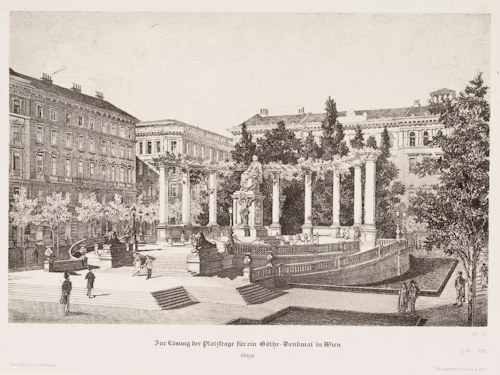
Vienna has hosted a literary staring competition for the last 150 years or so. On one side we have the German playwright and poet, Friedrich Schiller. He stands in bronze looking out from the Schillerpark. About 180m away, staring back, sits his bronze counterpart: a far more languid Johann Wolfgang von Goethe (1749-1832).
- Located (appropriately) on Goethegasse
- Monument unveiled in 1900
- Features a bronze figure of a seated Goethe
- Book a guided tour* of Vienna
- See also:
A bronze Goethe

(Johann seems pretty relaxed up there)
Vienna honours the memory of the greatest figure in German literature with, for example, a road named after him.
One end of Goethegasse sits just below the Albertina art museum in the old town. The other end has a seated bronze Goethe in his 50s.
According to newspaper reports of the time, Emperor Franz Joseph himself unveiled this Goethe monument on December 15th, 1900. Busy days for the monarch, since he did the same for the Gutenberg monument just two days later.
As well as a who’s who of court society, thousands of bystanders apparently followed proceedings eagerly.
The unveiling followed a long (20+ year) fundraising effort led by the Vienna Goethe Association. The Emperor contributed, as did other members of the Imperial family. The court theatre even chipped in with money earned from performances of Goethe’s works.

(Otto Wagner’s 1889 sketch imagining an alternative location and design for the Goethe monument in Vienna; Wien Museum Inv.-Nr. 96285/10; excerpt reproduced with permission under the terms of the CC0 licence)
The monument’s sculptor, Edmund Helmer, is better known for the famous Strauss memorial in Vienna’s Stadtpark. He deliberately refrained from excessive ornamentation on his Goethe design to ensure a focus on the figure alone.
(The emperor himself praised the simplicity of the approach when addressing Helmer at the unveiling.)
Helmer is said to have based his depiction of Goethe’s head on life masks taken in the early 1800s by Carl Gottlob Weißer and Johann Gottfried Schadow (though the latter version may simply have been a copy of the former).
The rear of the monument contains a relief intended to express that “the family, the people, and humanity revere Goethe’s genius”. The inscription simply says:
Erected by the Vienna Goethe Association in the year 1900
Commentators of the time praised the artistic merit of the monument, but seemed less happy with the somewhat isolated, bare location. The intervening years have at least given Goethe a green backdrop thanks to the trees planted behind the statue.
Equally, those same commentators conceded that the view across to the Schiller monument in the distance felt apt given the friendly relationship between the two literary greats.
Goethe also guards an entrance to the Burggarten, a nice patch of green that sits behind the Neue Burg wing of the Hofburg palace complex.
Go inside the park to find further statues, including ones of Emperor Franz Joseph and Mozart. The location also has small outdoor paddocks occasionally used by the stallions of the Spanish Riding School.
Take a quick look at Goethe’s nearest neighbour, too. Palais Schey dates back to the early 1860s: the dog’s head reliefs in the entrance doors carry bones in their jaws.

(View of Goethegasse, Palais Schey, and the future location of the Goethe monument on the left; Michael Frankenstein & Comp. (photo studio) around 1880; Wien Museum Inv.-Nr. 78079/610/2; excerpt reproduced with permission under the terms of the CC0 licence)
How to get to Goethe
You might pass Goethe as you wander the main central sightseeing areas, especially if you walk along the Ring boulevard taking in all the monumental buildings put up in the 19th century.
Subway: a short walk across from Karlsplatz station (U1, U2 and U4).
Tram/bus: Goethe sits halfway between two tram stops on the Ring. Burgring and Oper/Karlsplatz are both served by the 1, 2, D and 71 lines.
Address: Goethegasse 3, 1010 Wien